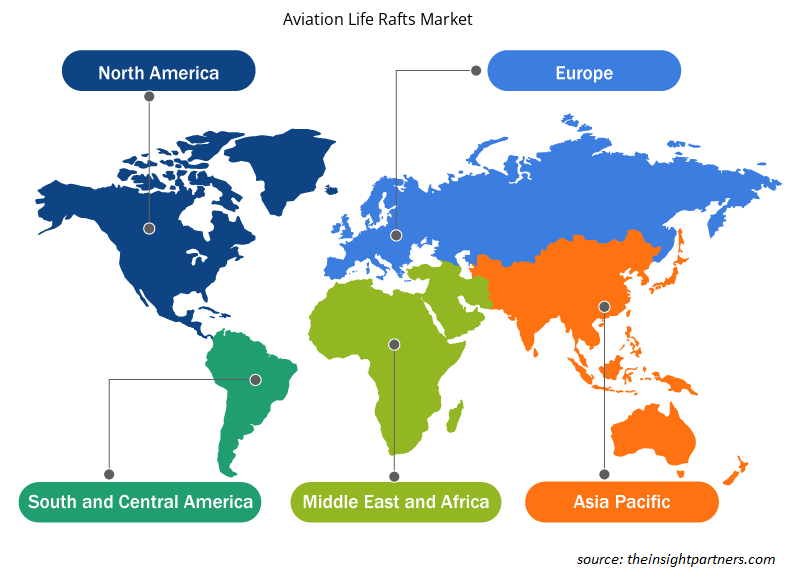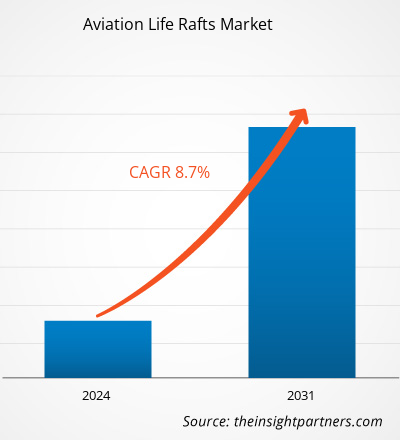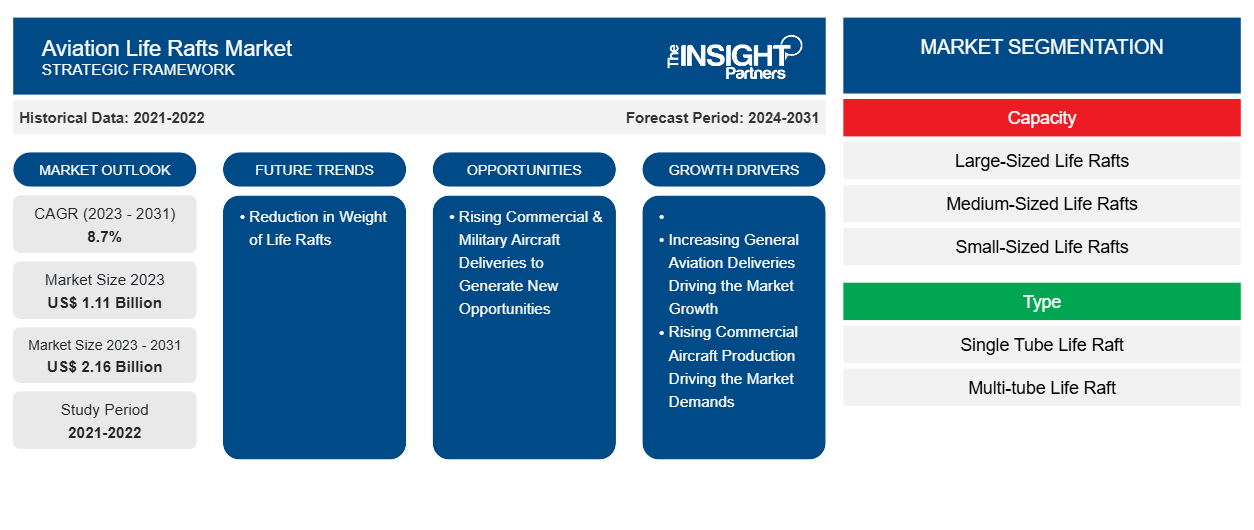Si prevede che il mercato delle zattere di salvataggio aeronautiche raggiungerà i 2,16 miliardi di dollari entro il 2031, rispetto agli 1,11 miliardi di dollari del 2023. Si prevede che il mercato registrerà un CAGR dell'8,7% nel 2023-2031. Gli operatori che operano nel mercato delle zattere di salvataggio aeronautiche offrono i loro prodotti con una durata utile di oltre dieci anni; tuttavia, la durata utile delle zattere di salvataggio è limitata a tre anni. La durata utile più breve consente all'utente finale di montare zattere di salvataggio più nuove ogni tre anni, il che avvantaggia l'utente finale garantendo un gonfiaggio regolare e ulteriori operazioni della zattera durante eventuali incidenti di atterraggio in acqua.
Analisi del mercato delle zattere di salvataggio per l'aviazione
Gli stakeholder chiave nel mercato delle zattere di salvataggio per l'aviazione sono i fornitori di materiali per zattere, i produttori di zattere di salvataggio per l'aviazione e gli utenti finali. La domanda di zattere di salvataggio per l'aviazione è elevata, a causa della crescente produzione di aeromobili e degli investimenti governativi. Le crescenti iniziative di R&S da parte di varie aziende stanno ulteriormente integrando la crescita del mercato aerospaziale globale. Nell'ecosistema di mercato, il fornitore di materiali per zattere offre vari materiali correlati alle zattere di salvataggio per l'aviazione. Alcuni dei fornitori di materiali per zattere come Trellborg AB, ContiTech AG e molti altri. Il produttore di zattere di salvataggio offre diversi tipi di zattere di salvataggio, alcuni dei produttori presenti sul mercato sono Collins Aerospace, Safran, Survitec Group Ltd. e molti altri. I produttori sono fortemente concentrati sull'espansione della propria base di clienti offrendo zattere di salvataggio innovative per l'aviazione. Gli utenti finali del mercato delle zattere di salvataggio per l'aviazione si procurano queste zattere di salvataggio direttamente dai produttori. Gli utenti finali nel mercato includono produttori di aeromobili, forze militari e operatori di aeromobili per l'aviazione generale.
Panoramica del mercato delle zattere di salvataggio per l'aviazione
La domanda di zattere di salvataggio per l'aviazione è determinata principalmente da alcuni dei fattori menzionati di seguito:
- L'aumento delle consegne di aviazione generale guida la crescita del mercato
- L'aumento della produzione di aeromobili commerciali guida la domanda del mercato
- Durata di vita più breve delle zattere di salvataggio aeronautiche
Questi fattori stanno costantemente guidando la crescita del mercato delle zattere di salvataggio aeronautiche in diverse regioni. Alcuni dei principali utenti finali delle zattere di salvataggio aeronautiche includono OEM di aeromobili commerciali e militari, OEM di aeromobili regionali e per l'aviazione generale e fornitori di MRO per aeromobili.
Personalizza questo report in base alle tue esigenze
Riceverai la personalizzazione gratuita di qualsiasi report, comprese parti di questo report, o analisi a livello nazionale, pacchetto dati Excel, oltre a usufruire di grandi offerte e sconti per start-up e università
-
Scopri le principali tendenze di mercato in questo rapporto.Questo campione GRATUITO includerà analisi di dati che spaziano dalle tendenze di mercato alle stime e alle previsioni.
Driver e opportunità del mercato delle zattere di salvataggio per l'aviazione
L'aumento delle consegne di aviazione generale guida la crescita del mercato
L'aumento del numero di consegne di aeromobili per l'aviazione generale probabilmente guiderà la crescita del mercato delle zattere di salvataggio per l'aviazione in diverse regioni. Secondo la General Aviation Manufacturers Association (GAMA), nel 2023 sono state consegnate circa 3.050 unità di aeromobili per l'aviazione generale in diverse regioni. Le consegne di aviazione generale hanno registrato una crescita del 9% nel 2023 rispetto al 2022. Inoltre, ci sono almeno due zattere di salvataggio su ciascuno degli aerei per l'aviazione generale che sono certificati secondo le norme FAA TSO-C70a. D'altro canto, le consegne di aeromobili con motore a pistoni hanno registrato una crescita a catena dell'11,8% (1.682 consegne) nel 2023; i jet aziendali hanno assistito a un aumento del numero di consegne che ammontava a 730 unità nel 2023 rispetto alle 712 unità nel 2022. Tali fattori stanno guidando la crescita del mercato delle zattere di salvataggio per l'aviazione in tutto il mondo.
Aumento delle consegne di aeromobili commerciali e militari per generare nuove opportunità
Il crescente numero di consegne di aeromobili commerciali è uno dei principali fattori che probabilmente genererà nuove opportunità per i venditori di mercato durante il periodo di previsione. Le consegne previste di aeromobili commerciali nei prossimi 20 anni genereranno probabilmente nuove opportunità per i venditori di zattere di salvataggio per l'aviazione negli anni a venire. Secondo diverse fonti aeronautiche, si prevede che entro il 2042 saranno consegnati oltre 40.000 nuovi aeromobili commerciali. Inoltre, l'approvvigionamento previsto di aeromobili militari è un altro fattore importante che probabilmente fornirà nuove opportunità per i produttori di zattere di salvataggio negli anni a venire. Ciò è anche supportato dai conflitti in corso tra diversi paesi come Russia-Ucraina, Israele-Palestina e Israele-Iran che hanno generato consapevolezza tra diverse nazioni per aumentare le rispettive forze militari. Per questo, diversi paesi hanno fornito diversi contratti ai produttori di aeromobili militari per vari tipi di aeromobili tra cui aeromobili da combattimento, aeromobili di sorveglianza, aeromobili cargo e petroliere per il rifornimento aereo. Tali fattori hanno spinto l'impiego di zattere di salvataggio anche nel segmento degli aeromobili militari.
Analisi della segmentazione del rapporto di mercato sulle zattere di salvataggio per l'aviazione
I segmenti chiave che hanno contribuito alla derivazione dell'analisi del mercato delle zattere di salvataggio per l'aviazione sono capacità, tipo, applicazione e geografia.
- In base alla capacità, il mercato è stato segmentato in zattere di salvataggio di grandi dimensioni, zattere di salvataggio di medie dimensioni e zattere di salvataggio di piccole dimensioni. Il segmento delle zattere di salvataggio di grandi dimensioni ha detenuto una quota di mercato maggiore nel 2023.
- Per tipologia, il mercato è stato segmentato in zattera di salvataggio a tubo singolo e zattera di salvataggio a più tubi. Il segmento delle zattere di salvataggio a più tubi ha detenuto la quota maggiore del mercato nel 2023.
- In termini di applicazione, il mercato è stato segmentato in aviazione generale, aviazione militare/di difesa e aviazione commerciale. Il segmento dell'aviazione generale ha dominato il mercato nel 2023.
Analisi della quota di mercato delle zattere di salvataggio aeronautiche per area geografica
L'ambito geografico del rapporto sul mercato delle zattere di salvataggio per l'aviazione è suddiviso principalmente in cinque regioni: Nord America, Europa, Asia Pacifico, Medio Oriente e Africa e Sud America.
Il Nord America ha dominato il mercato delle zattere di salvataggio aeronautiche nel 2023, mentre la regione Asia-Pacifico probabilmente assisterà a una crescita significativa durante il periodo di previsione. Gli Stati Uniti hanno rappresentato una quota di mercato maggiore nel mercato delle zattere di salvataggio aeronautiche del Nord America. Ciò è dovuto principalmente alla presenza di diversi produttori di zattere di salvataggio aeronautiche nel paese, ovvero: EAM Worldwide, Life Support International, Inc., Revere Survival Inc., AVI Aviation e Collins Aerospace tra gli altri, è una delle ragioni significative della crescita delle zattere di salvataggio aeronautiche nel paese. Inoltre, la spesa militare del paese è una delle più alte al mondo, il che supporta lo sviluppo della più grande flotta di aerei militari, aumentando così il mercato negli Stati Uniti. Inoltre, la presenza di importanti produttori di aeromobili per l'aviazione generale come Northrop Grumman e Raytheon Technologies tra gli altri, che richiede l'integrazione di zattere di salvataggio e cursori di evacuazione in questi aeromobili.
Approfondimenti regionali sul mercato delle zattere di salvataggio per l'aviazione
Le tendenze regionali e i fattori che influenzano il mercato delle zattere di salvataggio aeronautiche durante il periodo di previsione sono stati ampiamente spiegati dagli analisti di Insight Partners. Questa sezione discute anche i segmenti e la geografia del mercato delle zattere di salvataggio aeronautiche in Nord America, Europa, Asia Pacifico, Medio Oriente e Africa e America meridionale e centrale.

- Ottieni i dati specifici regionali per il mercato delle zattere di salvataggio per l'aviazione
Ambito del rapporto sul mercato delle zattere di salvataggio per l'aviazione
| Attributo del report | Dettagli |
|---|---|
| Dimensioni del mercato nel 2023 | 1,11 miliardi di dollari USA |
| Dimensioni del mercato entro il 2031 | 2,16 miliardi di dollari USA |
| CAGR globale (2023-2031) | 8,7% |
| Dati storici | 2021-2022 |
| Periodo di previsione | 2024-2031 |
| Segmenti coperti |
Per capacità
|
| Regioni e Paesi coperti |
America del Nord
|
| Leader di mercato e profili aziendali chiave |
|
Densità dei player del mercato delle zattere di salvataggio aeronautiche: comprendere il suo impatto sulle dinamiche aziendali
Il mercato delle zattere di salvataggio per l'aviazione sta crescendo rapidamente, spinto dalla crescente domanda degli utenti finali dovuta a fattori quali l'evoluzione delle preferenze dei consumatori, i progressi tecnologici e una maggiore consapevolezza dei vantaggi del prodotto. Con l'aumento della domanda, le aziende stanno ampliando le loro offerte, innovando per soddisfare le esigenze dei consumatori e capitalizzando sulle tendenze emergenti, il che alimenta ulteriormente la crescita del mercato.
La densità degli operatori di mercato si riferisce alla distribuzione di aziende o società che operano in un particolare mercato o settore. Indica quanti concorrenti (operatori di mercato) sono presenti in un dato spazio di mercato in relazione alle sue dimensioni o al valore di mercato totale.
Le principali aziende che operano nel mercato delle zattere di salvataggio per l'aviazione sono:
- EAM nel mondo
- Supporto alla vita internazionale, Inc.
- Società di Revere Survival Inc.
- Gruppo Safran
- Gruppo Survitec Limited
- Aviazione AVI
Disclaimer : le aziende elencate sopra non sono classificate secondo un ordine particolare.

- Ottieni una panoramica dei principali attori del mercato delle zattere di salvataggio per l'aviazione
Notizie e sviluppi recenti sul mercato delle zattere di salvataggio per l'aviazione
Il mercato delle zattere di salvataggio aeronautiche viene valutato raccogliendo dati qualitativi e quantitativi dopo la ricerca primaria e secondaria, che include importanti pubblicazioni aziendali, dati associativi e database. Di seguito è riportato un elenco degli sviluppi nel mercato delle zattere di salvataggio aeronautiche e delle strategie:
- A luglio 2023, AVI Survival Products ha lanciato la nuova zattera di salvataggio reversibile da 6 passeggeri. Il prodotto è dotato di un sistema autogonfiabile ad attivazione manuale, attivato tramite cordino, che garantisce una risposta rapida quando necessario. Il sistema di gonfiaggio comprende una bombola composita caricata con N2/CO2, un manometro e una valvola di gonfiaggio. Inoltre, la zattera di salvataggio reversibile è dotata di un coltello per zattera con un design a lama incassata, una cima di salvataggio che circonda il perimetro esterno della zattera, una calotta che può essere montata dopo l'imbarco, una cima di sollevamento e un anello conservati in una custodia ignifuga, una valigia per zattera/ancora galleggiante a doppio scopo appositamente progettata, ausili per l'imbarco posizionati strategicamente, un gruppo pompa manuale e un kit di attrezzature completo. (Fonte: FCAH Aerospace, comunicato stampa/sito Web aziendale/newsletter)
- Nel marzo 2022, Survitec ha presentato una "zattera di salvataggio monoposto più piccola e leggera" (SSLR) per equipaggiare al meglio i piloti di jet militari veloci nelle missioni più impegnative o quando sono costretti a eiettarsi dal loro aereo sull'acqua. (Fonte: Comtek Advanced Structures Ltd, comunicato stampa/sito Web aziendale/newsletter)
Copertura e risultati del rapporto sul mercato delle zattere di salvataggio per l'aviazione
Il rapporto "Dimensioni e previsioni del mercato delle zattere di salvataggio per l'aviazione (2021-2031)" fornisce un'analisi dettagliata del mercato che copre le seguenti aree:
- Dimensioni e previsioni del mercato a livello globale, regionale e nazionale per tutti i segmenti di mercato chiave coperti dall'ambito
- Dinamiche di mercato come fattori trainanti, vincoli e opportunità chiave
- Principali tendenze future
- Analisi dettagliata delle cinque forze di Porter
- Analisi di mercato globale e regionale che copre le principali tendenze di mercato, i principali attori, le normative e gli sviluppi recenti del mercato
- Analisi del panorama industriale e della concorrenza che copre la concentrazione del mercato, l'analisi della mappa di calore, i principali attori e gli sviluppi recenti
- Profili aziendali dettagliati con analisi SWOT
- Analisi storica (2 anni), anno base, previsione (7 anni) con CAGR
- Analisi PEST e SWOT
- Valore/volume delle dimensioni del mercato - Globale, Regionale, Nazionale
- Industria e panorama competitivo
- Set di dati Excel
Report recenti
Testimonianze
Motivo dell'acquisto
- Processo decisionale informato
- Comprensione delle dinamiche di mercato
- Analisi competitiva
- Analisi dei clienti
- Previsioni di mercato
- Mitigazione del rischio
- Pianificazione strategica
- Giustificazione degli investimenti
- Identificazione dei mercati emergenti
- Miglioramento delle strategie di marketing
- Aumento dell'efficienza operativa
- Allineamento alle tendenze normative























 Ottieni un campione gratuito per - Mercato delle zattere di salvataggio per l'aviazione
Ottieni un campione gratuito per - Mercato delle zattere di salvataggio per l'aviazione